卡博特 碳黑技术参数
- 格式:doc
- 大小:105.50 KB
- 文档页数:2
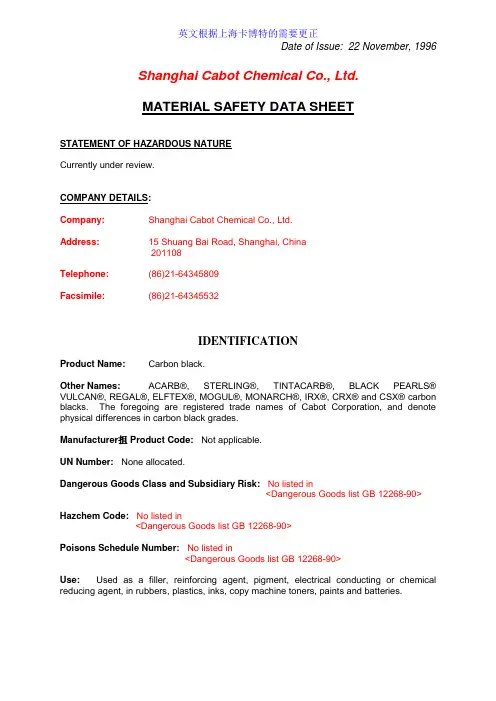

卡博特化工(山东)有限公司年产21万吨优质新工艺炭黑工程环境影响报告书(简本)1拟建工程简介卡博特化工(化工)有限公司21万吨优质新工艺工程属于新建项目。
拟建工程厂址位于济宁高新技术产业开发区内,国际大道以南,西浦路以东,兖州西站以北区域。
总投资9800万美元。
占地330000m2。
预计2009年12月投产。
拟建工程主要建设3条湿法造粒炭黑生产线及能源中心系统。
炭黑生产原料油采用蒽油、乙烯焦油、炭黑油、Decant Oil(进口油)、Carbon Black Oil(进口油)按一定比例的混合油,燃料采用天然气。
尾气发电锅炉燃料为炭黑尾气,来自拟建的炭黑生产线,用管道送至锅炉。
拟建工程劳动总定员110人,年工作时间计8208小时。
拟建工程用水由济宁市高新技术产业开发区建设局负责供给,自来水公司水源来自兖西水源地。
目前济宁市高新技术产业开发区内供水管网已建设完毕,供水能力能够确保拟建工程生产生活用水需要。
拟建工程组成中环保工程主要有炭黑粉尘除尘系统、粉尘浓度连续在线监测装置、废气集气排气设施、脱硫系统、废水治理措施、噪声治理设施、厂区绿化等,环保投资7351万元。
2工程建设产业政策符合性拟建工程符合《资源综合利用目录(2003年修订)》、《国家鼓励发展的资源节约综合利用和环境保护技术》、《橡胶工业'十一五'科学发展规划意见》、《当前优先发展的高技术产业化重点领域指南(2007年度)》、《产业结构调整指导目录(2005年本)》鼓励类、《“十五”我国橡胶加工及炭黑工业环保技术及措施》等要求。
拟建工程不属于《关于进一步加强产业政策和信贷政策协调配合控制信贷风险有关问题的通知》当前部分行业制止低水平重复建设目录、《产业结构调整指导目录(2005年本)》淘汰类、限制类。
综上所述,拟建工程建设符合相关国家产业政策要求。
3工程建设城市总体规划符合性根据《济宁高新技术产业开发区总体规划(2003-2020)》,济宁高新技术产业开发区功能定位为:以高新技术产业和外向型经济为主的综合性工业园区和集商贸、科研、生活服务于一体的现代化城市新区。
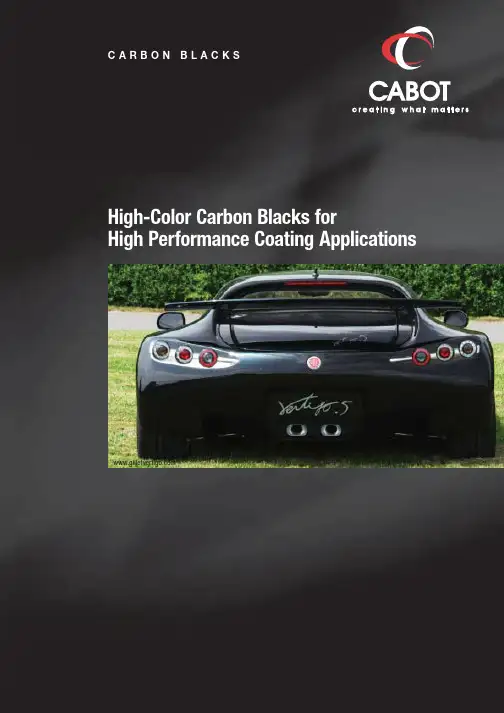
2Table of contents252000 561515Introduction Hig h jet masstone is a requirement of hig h-end performancecoating applications such as automotive OEM or automotiverefinish. The demand for increased jetness has heightened with theemerg ence of new resin technolog y. For this reason, raw materialand dispersion equipment suppliers have looked for ways to improvetheir products. In this respect, Cabot Corporation is no exceptionand continues to supply the market with innovative ideas for blackpigments that meet current market needs.This technical paper presents a summary of information reg ardingthe effect certain fundamental properties of carbon black may haveon coatings performance.It also outlines information on Cabot’s core line of hig h-colorcarbon black pig ments, including the well-established MONARCH1300 and MONARCH 1400 carbon blacks. Also covered aretwo new pigments, MONARCH 1500 carbon black and the revolu-tionary EMPEROR 2000 carbon black. While MONARCH 1300,MONARCH 1400, and MONARCH 1500 carbon blacks areoxidized pig ments, EMPEROR 2000 carbon black is based onCabot’s proprietary surface modification technology.This brochure demonstrates the ability of EMPEROR 2000 carbonblack to impart superior jetness in high performance coating applica-tions. The test criteria used to collect and to compare performancedata on these grades are highlighted in Section II of this brochure.3High-Color Carbon Blacks for High Performance Coating ApplicationsI. Carbon Black Properties and Coating PerformanceOne of the major reasons carbon black is used in coating applications isfor its color properties. Color development can be measured by conver-ting the color spectral reflectance data into three-dimensional colorspace, as provided by the Hunter Color formula measurements, asshown here.In automotive topcoat applications, extreme black (low L* values) anddeep blue undertones (low b* values) are the desired colors. The keyproperties of carbon black that can affect this color goal are:1. Primary particle size/surface area2. Primary aggregate shape/morphology3. Surface chemistry■ Effect of Primary Particle SizeMost pigments absorb and scatter portions of the visible light spectrum.The color of paint depends on how well the pigment is able to absorband scatter light. Carbon black can be used to help increase the amountof light absorbed by a coating because it can absorb and scatter lightmore effectively than many other pigments.As a carbon black’s primary particle size decreases, more surface areabecomes available to incident light.Also, primary aggregates tend to be smaller, assuming a constantstructure level, resulting in a finer carbon black. The overall effect of thefiner carbon black particle size is increased light absorption and moreefficient light scattering, giving a blacker or “jetter” color.Hunter Color Definition■ Effect of StructureA carbon black characterized by aggregates composed of many pri-mary particles with considerable branching or chaining is referred to asa “high structure” black. Conversely, an aggregate having relatively fewparticles forming a more compact unit is a “low structure” black.As structure increases, the absorption and scattering efficiencies aredecreased. Thus, in primary particles of the same size, a high structureblack will exhibit lower jetness than a black having low structure.■ Effect of Surface ChemistryIncreasing the volatiles content (that is, chemisorbed oxygen complex-es) on the surface of carbon black will generally increase dispersibilityand lower viscosity in liquid systems. The dispersibility of carbon blackcan also be enhanced through the adsorption of a limited amount ofmoisture on its surface.To some extent, both the volatiles content and adsorbed moisture canfunction as surfactants, whereby the surface is more readily “wetted” bythe vehicle. However, as the volatiles content of carbon black increases,its surface becomes more acidic. Thus, care should be taken whenformulating coatings systems.■ Physical formMost commercial high-color carbon blacks are available in either fluffyor pellet form. The pellet form handles more easily (reduced dusting) andnormally costs less than the fluffy form. However, the process of densi-fication, which is used to create the pellet form, tends to pack carbonblack agglomerates more closely, making dispersion more difficult thanwith the fluffy form.4II. High-Color Carbon Blacks: Cabot MONARCH/ BLACK PEARLS 1300 & 1400, MONARCH 1500, and EMPEROR 2000 Carbon Blacks■ Properties of an ideal high-color black for coatingsAn ideal high-color carbon black should provide superior “jetness” in high-color enamels or lacquer coatings. As explained above, key properties of such a carbon black would include sufficiently fine-sized primary particles for increased light absorption and lower structure for increased light scat-tering.The volatiles content and moisture level also can be adjusted to improve dispersibility. When these properties are obtained, superior “jetness” in high performance coating systems can be achieved.■ MONARCH/BLACK PEARLS 1300 & 1400,MONARCH 1500 and EMPEROR 2000 Carbon BlacksMONARCH/BLACK PEARLS 1300 & 1400, MONARCH 1500 and EMPEROR 2000 are commercially available Cabot highcolor carbon blacks. Because of their properties, Cabot believes that they are able to impart superior “jetness” for high performance coating applications. They exhibit a very fine primary particle size (9-13 nanometers) for increased light absorption combined with a low structure (90-100 DBP) for increased light scattering. Together, these properties help to achieve superior color “jetness” and improved gloss in high performance coating systems. Additionally, the specifications for volatiles content and moisture levels of these Cabot carbon blacks are optimized to help maintain dispersibility. MONARCH/BLACK PEARLS 1300 & 1400, MONARCH 1500 are Cabot oxidized high-color carbon blacks. These high-color carbon blacks are produced through the process of chemisorption of oxygen complexes onto the carbon black surface.EMPEROR 2000 carbon black is Cabot’s newest pigment black and is produced using an innovative chemical modification technology. This patented technology allows specific functional groups to be grafted onto the surface of the carbon black particle. F or EMPEROR 2000, the function of the attached groups is twofold: first, it helps to anchor adsorbed surfactants and dispersants that otherwise can float free of the carbon black surface and affect coating performance, and secondly, it improves the ease of dispersion and dispersion stability of the carbon black yielding the desired coating jetness with a strong blue undertone. The new technology is illustrated here.Conventional Commercial Carbon Black After-treatmentsCabot's New Surface Treatment (Chemical Modification)5■ Performance Comparison StudyCabot’s MONARCH 1300, 1400 & 1500, and EMPEROR 2000 carbonblacks were first tested in high-solids automotive topcoat acrylic formu-las for this comparison study. An in-house Cabot application develop-ment group developed the formulations based on high-solids acrylicpolyol resin suitable for one-component thermoset coatings. The formu-lation also contained a reactive melamine formaldehyde crosslinker. Thecarbon black dispersing agent used was a solution of high molecularweight blocked copolymer with cationic activity. A mixture of aromaticand ester solvents was used to help control the viscosity of the coatingformulation.The above carbon blacks were evaluated also in water-borne acryliclatex automotive base-coat formulas. This formulation also was devel-oped by our in-house applications development group. In addition tothe acrylic resin, the formulation consisted of a melamine formaldehyderesin as a crosslinker, a non-ionic low molecular weight dispersing agentand, for film formation, a mixture of propylene glycol n-butyl ether anddipropylene glycol n-butyl ether solvents.The formulations, performance properties and test results of both thehigh-solids acrylic and water-borne acrylic enamels are described in thesections A and B below. Additionally, accelerated weathering results aregiven for the water-borne acrylic enamel.High-Solids Acrylic EnamelMillbase Formulation:Butyl acetate, DisperBYK 161 and carbon black were premixed usinggood agitation to wet-out the pigment. Setalux 27.1597 was thenadded under good agitation. Once the resin was incorporated, the mill-base was premixed at 4,000 RPM for 20 minutes. The millbase wasthen charged to a horizontal mill along with 0.6-0.8 mm zirconium sili-cate media. The millbase was ground at 10m/sec. tip-speed to achieveparticle sizes of <5 microns on the Hegman Scale.6Letdown Masterbatch Formulation:The following materials were mixed together under good agitation.Finish masstone formulation:To prepare the finish formulation, 10 parts of the millbase and 50 parts ofthe letdown masterbatch were added together using good agitation forapproximately 20 minutes before application.Finish Masstone Formulation Constants:Carbon back loading in millbase (%) 10Dispersant/Carbon black solids ratio 0.975/1.00Pigment/Binder solids ratio 0.028/1.00Crosslinker %, solids 25Carbon black loading on total formulation (%) 1.67Performance Properties of High-Solids Acrylic EnamelPaint viscosities were adjusted with Aromatic 100 to 30 seconds with aNo.4 F ord cup. The paints were then sprayed out with a 665SX66SDnozzle using air assist applied at 35 psi. The final coating film thicknessand curing schedule were as follows:Monocoat Application:MasstoneAfter curing, the high-color pigment black panels were measured forcolor development and gloss. Color measurements were determinedusing a Hunter Labscan colorimeter using (45,0) geometry, CIELabequation, D-65 illuminant, and 10 degree observer. Gloss measurementswere determined using BYK Gardner Glossmeter. Similar gloss readingswere obtained for each of the carbon black formulations. The colordevelopment results are shown in the following table and in the chartsbelow. The results illustrate the increased jetness achieved when usingMONARCH 1500 and especially EMPEROR 2000 carbon blacks. Both L*values and Mc values are improved over those of MONARCH 1300 &1400 carbon blacks.781.41.210.80.60.40.2-0.2-0.4300275250225200Masstone9Finish masstone formulation:To prepare the finish formulation, 20 parts of the millbase and 182.9 partsof the letdown masterbatch were added together using good agitation forapproximately 20 minutes before application.Finish tinting formulation (10/90):To prepare the finish tinting formulation, 5 parts of the millbase concentrateformulation and 45 parts of the finish white base (TrueValue Weatherall100% Acrylic Latex GHP-9 White) were add together under goodagitation for approximately 20 minutes before application.Formulation Constants:Carbon back loading in millbase (%) 13.5Dispersant/Carbon black solids ratio 0.25/1.00Total solids by weight in final letdown (%) 35.0Pigment/Binder solids ratio 0.04/1.00Crosslinker %, solids 15Carbon black loading on total formulation (%) 1.33Performance Properties of Water-borne Acrylic LatexEnamelPaints were sprayed out using a 665SX66SD nozzle with air assistapplied at 35 psi. The final coating film thickness and curing schedulewas as follows:Monocoat Application:After curing, high-color pigment black panels were measured for colordevelopment and gloss. Color measurements were determined using aHunter Labscan colorimeter using (45,0) geometry, CIELab equation,D-65 illuminant, and 10 degree observer. Gloss measurements weredetermined using BYK Gardner Glossmeter. Similar gloss readings wereobtained for each of the carbon black formulations. The color develop-ment results are shown in the following table and in the charts below.The results illustrate the increased jetness achieved when usingMONARCH 1500 and especially EMPEROR 2000 carbon blacks. BothL* values and Mc values are improved over those of MONARCH 1300& 1400 carbon blacks. F urther, EMPEROR 2000 exhibits better bluetone than all other carbon blacks used in this formulation.1011Masstone21.510.50-0.5-130027525022520012TintingAccelerated weathering was performed with a QUV tester. The test wasbased on the ASTM 4587-91 method using UV-B fluorescent lamps. The tester was set at 4 light cycles followed by 4 condensation cycles. After 1000 hours of exposure, the panels were removed for evaluation. Weathering results are shown in the table below. Similar results are obtained for MONARCH 1300, 1400 and 1500, while EMPEROR 2000showed improved resistance to whitening and color retention.454035302520151050-5III. Formulation Guide■ The following modifiers were also used in our evaluationsof carbon black color performance:Dispersion AgentSince high-color blacks consist of small particle sizes, high surface areas,and high structures, dispersion and stability are much more difficult toachieve than with other carbon black grades. Dispersion agents arehighly recommended for dispersion and stability of high-color blacks incoating systems.The following dispersion agents and usage levels were used in ourevaluation:For Solvent-Borne Systems:Or a combination of Solsperse 32500 (0.50 - 0.60) and Solsperse 5000(0.10 - 0.20 parts per 1 part carbon black) may be used.For Water-Borne Systems:SurfactantSurfactant addition is also required in order to increase the dispersibilityand stability of water-borne formulations. The following surfactants wereused in our study of the water-borne acrylic latex system:13Leveling AgentSince substrates can be difficult to wet-out, especially withwater-borne coatings, wetting agents are required for waterborneformulations so that good, continuous film formation maybe achieved. Wetting (or leveling) agents can also eliminate filmdefects, such as orange peel, cratering or shrinkage. Thefollowing leveling agents were used in our comparison study:For Solvent-Borne Systems:For Water-Borne Systems:DefoamerF oaming in water-borne formulations is extremely difficult to control.Adding defoamer is a must to minimize the foaming effect in thesesystems. The following defoamers were used in our evaluation of water-borne acrylic latex systems:Dispersion ProcessOptimum dispersion of carbon black is necessary in order to achievesuperior color development in coatings formulations. All agglomeratesmust be broken down to primary aggregates to realize the full potentialof the optically functional units. Any degree of dispersion less than theoptimum will result in poorer jetness. The energy required for optimumdispersion must be supplied in the form of some type of media mill.14Definitions:DFT = Dry Film ThicknessL* is a measure of the lightness/darkness (lower numbers indicate darker color)b*is a measure of blue/yellow (lower numbers indicate bluer color)a* is a measure of red/green (lower numbers indicate a greener color) Mc: Mc is the Color Dependent Black Value and was developed by K. Lippok-Lohmer (Farbe + Lack, (1986), vol. 92, p. 1024). It is defined by the equation Mc = 100[log(Xn/X) - log (Zn/Z) + log (Yn/Y)], where X, Y, and Z are measured tristimulus values. The Mc value correlates well with the human perception of increased jetness. As the Mc value increases, the jetness of the masstone increases.Raw Material Suppliers*Setalux™ 27.1597 Akzo Nobel800.292.2308Solsperse® 5000 AveciaSolsperse® 32500 704.672.9920BYK® 024 BYK-ChemieBYK® 346 203.265.2086BYK® 348 BYK® 358DisperBYK® 161DisperBYK® 180DisperBYK® 2000Triton™ X-100 Dow ChemicalAMP-95™ 800.447.4369D-1441 Baker Petrolite781.335.6668Dehydran® 1293 CognisDehydran® 1620 215.628.1000Nopco® NS-1 Cymel® 202 Cytec Industries, Inc.Cymel® 373 847.652.6013EFKA® 3570 EFKA Additives440.943.4200Arcosolve™ PnB LyondellArcosolve™ DPnB 888-777-0232NeoCryl™ XK-100 NeoResins (Avecia)978.658.6600TEGO Dispers™ 760W TEGO Chemie800.446.1809* All raw materials used were North American versions.150908Europe +32 16 39 24 00+32 16 39 24 44North America )800 526 7591 Latin America+55 11 2144 6400(Middle East/Africa+971 4 8871 800Pacific/Asia+60 3 2096 3888China+86 21 5175 8800+86 21 6434 5532JapanA d d r e s s e s。
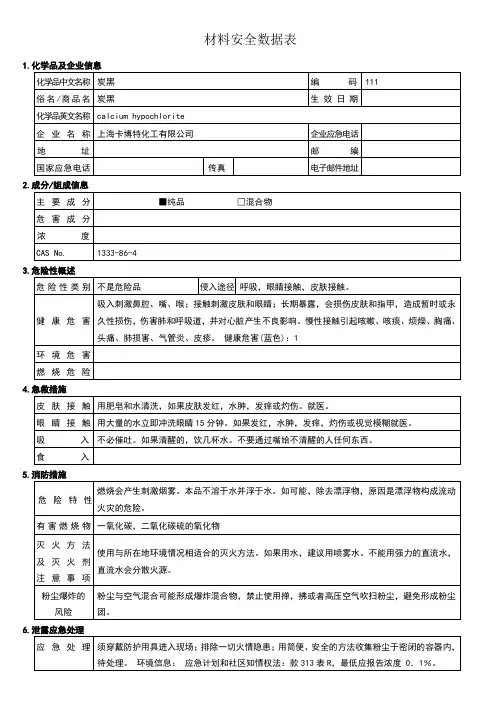
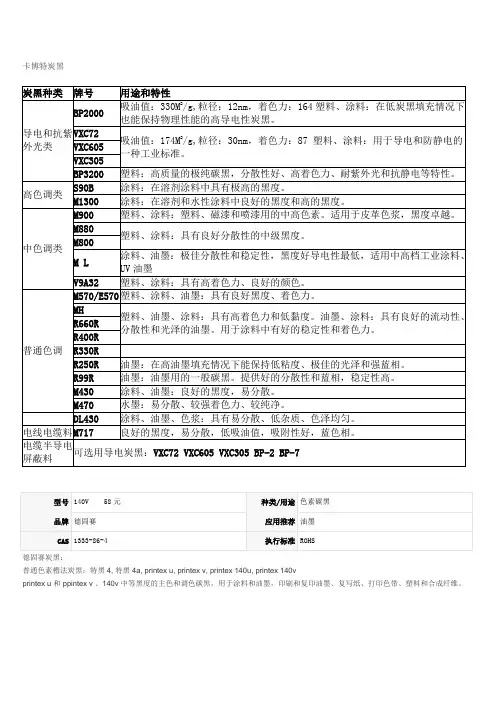
卡博特炭黑德固赛炭黑:普通色素槽法炭黑:特黑4, 特黑4a, printex u, printex v, printex 140u, printex 140vprintex u 和ppintex v 、140v中等黑度的主色和调色碳黑,用于涂料和油墨,印刷和复印油墨、复写纸、打印色带、塑料和合成纤维。
德固赛炭黑:普通色素槽法炭黑:特黑4, 特黑4a, printex u, printex v, printex 140u, printex 140v,50L,900Lprintex u 和ppintex v 、140v中等黑度的主色和调色碳黑,用于涂料和油墨,印刷和复印油墨、复写纸、打印色带、塑料和合成纤维。
分散性能好,光泽度佳,耐高温。
环保,通过SGS认证。
卡博特炭黑M1400 BP1400 M1300 BP1300 M1000 BP1000 M900 BP900 M880 BP880 M800 BP800 XC-72 XC-72R M-L BP-L R660R R660 R400R R400M-H R330R R330 E-415 M430 BP430 D430R250R R250 R99R R99 M280 BP280 M120 BP120 M1100 M700 R300 R N115 E-12 E-8 ES90B M1500 XC-68 XC-200XC-305 N330 N774 N110 N375 N220 N347 N326 N762 N134 N66 0 N550 N717 N650 N234 N683 N772 SP5000SP6000 N339 N375 SP5000A N121 N539 SP6400 V1463BP2000 M570 BP470橡胶用炭黑N115,N220,N234,N330,N550,N660,N774,SP5000等涂料用炭黑M1300,M1100,M900,M-L,R660R,R400R等油墨用炭黑DL-430-,M-E,M-H,R400R,R99R,VXC72,VXC72R等塑料用炭黑DL-8,DL-3,DL430,V9A32,M717,BP800,BP900,BP2,BP7,BP280等导电炭黑 VXC305,VXC605,VXC72,VXC500,BP2000等原包装,高浓度,易分散韩国KCB 进口:HI BLACK 50L\HI BLACK 900L 高黑度 蓝色相 分散性好通用于塑料行业包括:LDPE 、HDPE 、PP 、EC 、PS 、SAN 、PMMA 、PU 及软\硬质PVC 塑料着色用色素炭黑色母粒吹膜母粒推荐使用 HIBLACK 30L 易分散的中色素碳黑,用于水性柔版印刷油墨,塑料和色母生产。
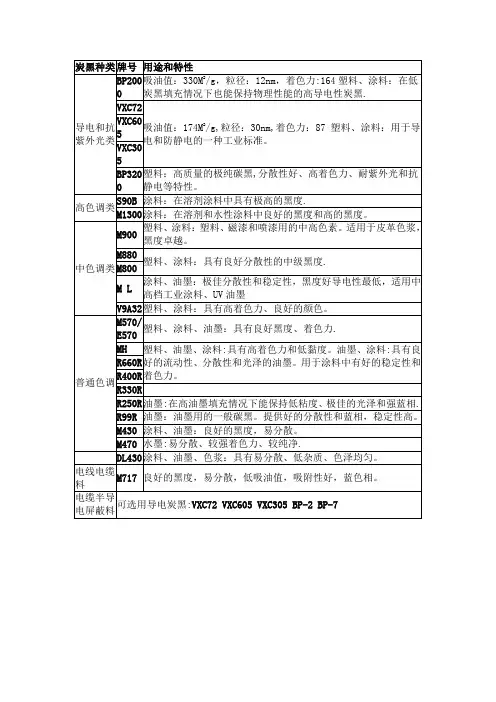
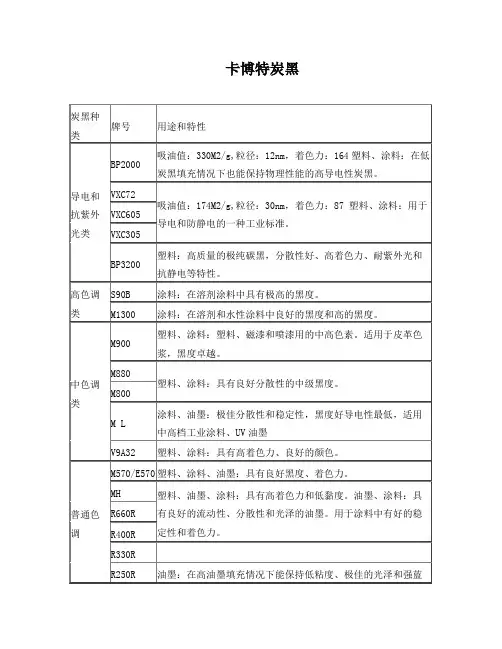
卡博特炭黑德固赛炭黑:普通色素槽法炭黑:特黑4, 特黑4a, printex u, printex v, printex 140u, printex 140vprintex u 和ppintex v 、140v中等黑度的主色和调色碳黑,用于涂料和油墨,印刷和复印油墨、复写纸、打印色带、塑料和合成纤维。
德固赛炭黑:普通色素槽法炭黑:特黑4, 特黑4a, printex u, printex v, printex 140u, printex 140v,50L,900L printex u 和ppintex v 、140v中等黑度的主色和调色碳黑,用于涂料和油墨,印刷和复印油墨、复写纸、打印色带、塑料和合成纤维。
分散性能好,光泽度佳,耐高温。
环保,通过SGS认证。
卡博特炭黑M1400 BP1400 M1300BP1300 M1000 BP1000 M900 BP900 M880 BP880 M800 BP800 XC-72 XC-72R M-L BP-L R660R R660 R400R R400 M-H R330RR330 E-415 M430 BP430 D430R250R R250 R99RR99 M280 BP280 M120 BP120 M1100 M700 R300R N115 E-12 E-8 ES90B M1500 XC-68 XC-200XC-305 N330 N774 N110 N375 N220 N347 N326 N762 N134 N66 0 N550 N717 N650 N234 N683 N772 SP5000SP6000 N339 N375 SP5000A N121 N539 SP6400 V1463BP2000 M570 BP470橡胶用炭黑N115,N220,N234,N330,N550,N660,N774,SP5000等涂料用炭黑M1300,M1100,M900,M-L,R660R,R400R等油墨用炭黑DL-430-,M-E,M-H,R400R,R99R,VXC72,VXC72R等塑料用炭黑DL-8,DL-3,DL430,V9A32,M717,BP800,BP900,BP2,BP7,BP280等导电炭黑VXC305,VXC605,VXC72,VXC500,BP2000等原包装,高浓度,易分散韩国KCB进口:HI BLACK 50L\HI BLACK 900L高黑度蓝色相分散性好通用于塑料行业包括:LDPE、HDPE、PP、EC、PS、SAN、PMMA、PU及软\硬质PVC 塑料着色用色素炭黑色母粒吹膜母粒推荐使用 HIBLACK 30L 易分散的中色素碳黑,用于水性柔版印刷油墨,塑料和色母生产。
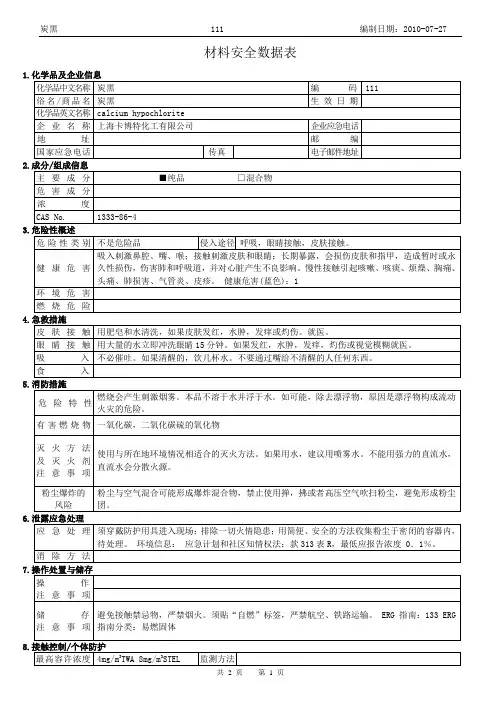
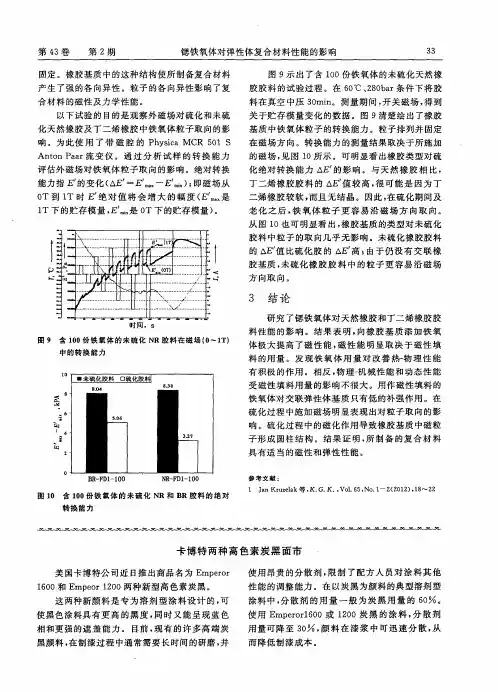
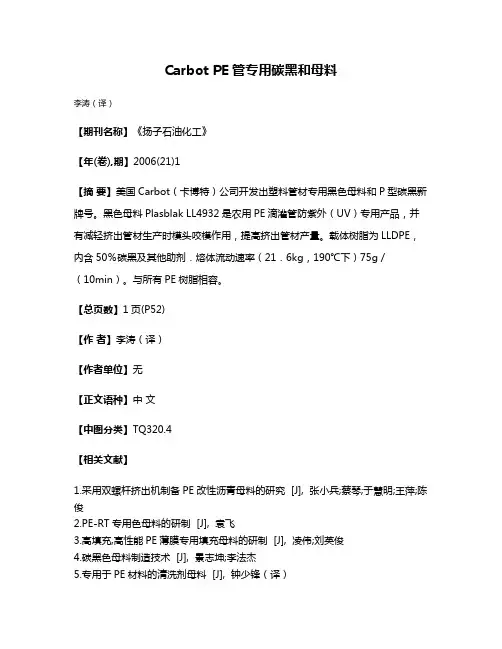
Carbot PE管专用碳黑和母料
李涛(译)
【期刊名称】《扬子石油化工》
【年(卷),期】2006(21)1
【摘要】美国Carbot(卡博特)公司开发出塑料管材专用黑色母料和P型碳黑新牌号。
黑色母料Plasblak LL4932是农用PE滴灌管防紫外(UV)专用产品,并有减轻挤出管材生产时模头咬模作用,提高挤出管材产量。
载体树脂为LLDPE,内含50%碳黑及其他助剂.熔体流动速率(21.6kg,190℃下)75g/
(10min)。
与所有PE树脂相容。
【总页数】1页(P52)
【作者】李涛(译)
【作者单位】无
【正文语种】中文
【中图分类】TQ320.4
【相关文献】
1.采用双螺杆挤出机制备PE改性沥青母料的研究 [J], 张小兵;蔡琴;于慧明;王萍;陈俊
2.PE-RT专用色母料的研制 [J], 袁飞
3.高填充,高性能PE薄膜专用填充母料的研制 [J], 凌伟;刘英俊
4.碳黑色母料制造技术 [J], 景志坤;李法杰
5.专用于PE材料的清洗剂母料 [J], 钟少锋(译)
因版权原因,仅展示原文概要,查看原文内容请购买。

及更具可持续性。
杜邦酶制剂在广阔的家居和个人护理产品领域,特别是在洗衣和清洁领域,推动了可持续性的进步。
卡酋特珊台公司通辺RC14001朮土*证波士顿-卡博特公司(NYSE:CBT)宣布在中国邢台的炭黑生产工厂已正式通过RC14001本土认证。
RC14001体系认证技术规范就是将美国化工协会(“ACC”)责任关怀的倡议和1996年由国际标准化组织(“ISO”)通过并于2015年修订ISO14001环境管理体系的结合,也是全球公认的安全、健康、环境和安保管理体系的黄金法则。
通过RC14001体系认证,ACC确保其成员持续地落实国际标准ISO 14001:2015——环境管理体系和附加的责任关怀内容(职业安全一ISO45001、社区认知和应急、工艺安全、产品安全、运输和储存安全、安保)的要求,以对合作伙伴、员工、承包商和社区产生积极的影响,从而实现促进全球化工行业实现卓越的业绩同时增加透明度。
台歌將在CESli示穴量硬件今年2月份,谷歌将智能家居设备制造商Nest重新纳入其领导范畴。
此前Nest作为谷歌母公司Alphabet旗下的半独立子公司度过了两年时间。
谷歌此举得以将智能恒温器、烟雾探测器和安全摄像头整合到其整体产品线中。
该公司还在计划稳步扩大其Google Home产品线。
去年10月,谷歌发布了可以向用户展示菜谱或视频的智能显示屏Home Hub0这款平板电脑类似于上一届国际消费电子展上该公司与联想和索尼等厂商合作推出的智能显示屏,不过这次是谷歌品牌的硬件设备。
同样在10月份,谷歌发布了新版的旗舰手机Pixel3,有科技媒体称其为“2018年最佳Andriod手机”。
情况并非总是如此。
此前,谷歌非常大的硬件项目之中还包括Nexus Q流媒体设备和备受争议的谷歌眼镜等失败产品。
但在2016年,谷歌聘请摩托罗拉前高管里克•奥斯特洛(Rick Osterloh)领导新部门,负责谷歌所有不同的硬件项目,并创建了一系列具有凝聚力的产品。
项目Item单位Unit 测试方法Testing methodN115N220N234N326N330N339N375N550N660N774SP5000吸碘值I2No g/kgASTMD1510160+/-6121+/-5120+/-582+/-582+/-590+/-590+/-543+/-436+/-432+/-527+/-4吸油值DBP ml/100g ASTMD2414113+/-5114+/-5125+/-572+/-5102+/-5120+/-5114+/-5121+/-590+/-575+/-5120+/-6压缩样吸油值CDBP ml/100g ASTMD349397+/-598+/-5101+/-569+/-588+/-599+/-596+/-583+/-573+/-565+/-580+/-4着色强度Tint %ITRB ASTMD3265123+/-5116+/-5124+/-5111+/-5104+/-5112+/-5113+/-559+/-560+/-660+/-545+/-4氮吸附比表面积N2SA m2/g ASTMD6556137+/-5114+/5119+/-578+/-578+/-591+/-593+/-540+/-435+/-4外表面积STSA m2/g ASTMD6556124+/-5104+/-5112+/-576+/-574+/-587+/-588+/-539+/-535+/-532+/-528+/-4细粉含量Fine %ASTMD15081010101010101010101010加热减量'Heat Loss %ASTMD1509 3.0 2.5 2.5 2.5 2.5 2.5 2.5 1.5 1.5 1.5 1.535目筛余物35 mesh Sieve Residue ppm ASTMD15141010101010101010101010120目筛余物120 mesh Sieve Residue ppm ASTMD15143030325目筛余物325 mesh Sieve Residue ppm ASTMD1514500500500500500500500500500500100灰分Ash%ASTMD1506 1.01.01.01.01.01.01.01.01.01.01.0堆积密度Pour Density kg/m3ASTMD1513345+/-40355+/-40320+/-40455+/-40380+/-40345+/-40345+/-40360+/-40440+/-40490+/-40385+/-40300%定伸应力 300%ModulusMpaASTMD412-3.1+/-1.0-2.0+/-1.0-0.1+/-1.0-3.6+/-1.0-0.6+/-1.0+0.9+/-1.00.4+/-1.0-0.6+/-1.0-2.3+/-1.0-3.8+/-1.0Type 形式Weight 重量(Kg)Bulk 槽车5000IBC 太空包1000Paper bag 纸袋25 ,20Rubber Black Specifications of Cabot 上海卡博特橡胶用炭黑指标1.Technical Specification 技术指标2.Packing type 包装方式备注Note:1:300%定伸是根据ASTM D-3192天然胶在145度下硫化30分钟,然后测量其与IRB#7的相对值。
卡博特碳黑技术参数卡博特(Carbot)是一种碳黑,是一种颗粒状的混合物,主要由碳元素组成。
碳黑是通过热分解或不完全燃烧有机化合物而产生的一种黑色固体材料。
卡博特是一种常见的碳黑材料,具有许多技术参数。
1.颗粒形状和大小:卡博特的颗粒形状呈聚集状,通常呈团状或链状。
颗粒的大小取决于生产过程中的控制方法和需求,可以由纳米尺寸到微米尺寸。
2.表面积:卡博特的表面积是一个重要的技术参数,通常以比表面积来衡量。
比表面积越大,表明碳黑颗粒的表面积更大,也就意味着更多的活性表面。
3.pH值:pH值是衡量卡博特酸碱性的指标。
卡博特具有较低的pH值,通常在2-9之间,这与其表面上的羟基和羧基有关。
4.碳含量:卡博特的碳含量很高,通常在90-99%之间。
高纯度的碳黑可以用于各种应用,包括橡胶、颜料、塑料、电子材料等。
5. 密度:卡博特的密度通常在1.8-2.1 g/cm³之间。
这意味着它是一种相对较重的物质,拥有较大的质量。
6.比重:卡博特的比重通常在1.8-2.1之间。
比重是物质的密度与水的密度之比,越大表示对水的相对“沉重”。
7.光学性质:卡博特可以吸收大部分光线,使其呈现黑色。
其吸光能力与颗粒的大小和形状有关,颗粒越细小越吸光。
8.热导率:卡博特的热导率很低,通常在0.05-0.1W/m·K之间。
这种低热导率使得卡博特成为一种优秀的绝缘材料,可用于隔热材料。
9.化学稳定性:卡博特具有良好的化学稳定性,能够在常温下抵抗大部分化学物质的侵蚀。
然而,在高温或极端条件下,卡博特可能发生腐蚀或氧化反应。
10.电导率:由于卡博特具有一定的导电性,可以用作电导材料。
其电导率取决于碳黑的结构和纯度。
总之,卡博特是一种重要的碳黑材料,具有多种技术参数。
这些参数决定了其在不同应用中的性能和适用性。
炭黑工艺及分析炭黑工艺及分析一、概述炭黑是气态或液态的碳氢化合物在空气不足的条件下进行不完全燃烧或热裂分解所生成的无定形碳,为疏松、质轻而极细的黑色粉末物质,具有高度分散性。
不溶于各种溶剂,相对密度1.8~2.1。
其成分主要是元素碳,并含有少量氧、氢和硫以及其他杂质和水分等,其微晶具有准石墨结构。
炭黑的主要物理性质有比表面积、密度、结构性、表面性质、导热性、导电性和光学性质等;主要化学性质有氧化、接枝和磺化等反应性以及催化作用、消除自由基作用和抗老化性作用等。
各种炭黑的差异主要在表面积(或粒子大小)、聚集体形态、粒子和聚集体的质量分布和化学组成等方面。
炭黑主要用作橡胶的补强剂和填料,其消耗量约为橡胶消耗量的一半,橡胶用炭黑占炭黑总量的94%,其中约60%用于制造。
此外,也用作油墨、和的着色剂以及塑料制品的紫外光屏蔽剂。
在许多其他制品,如电极、干电池、电阻器、炸药、化妆品及抛光膏中,它也是重要的助剂。
二、市场分析炭黑系芳族石油或煤焦油等原料不完全燃烧的产物,作为重要的填充补强剂和优良的着色或调色剂,目前广泛应用于橡胶及塑料加工、油墨、涂料、化纤、制革、电子,冶金等行业.橡胶用炭黑约占炭黑总耗用量的90%,其使用不仅能提高橡胶制品的强度,而且能改进胶料的工艺性能,赋予制品耐磨、耐撕。
耐热等多种性能,延长制品的使用寿命,适量填充炭黑还可以降低生产成本.据不完全统计,根据轮胎和橡胶加工的发展,以及炭黑相关应用领域的需求,据统计,全球工业企业每年消耗800万~900万吨炭黑,中国的炭黑年消费量为110万吨,是仅次于美国的全球第二大炭黑消费国。
目前国内炭黑生产能力为200万吨,2004年总产量为138万吨,表现消费量已达到140万吨.2006年我国炭黑产量为182.5万吨。
预计2010年全国炭黑的需求量将达到200-220万吨.中国汽车制造业及轮胎制造业的迅猛发展导致近年来对炭黑的需求量急剧提高。
我国高速公路近年来取得了快速发展,轮胎对高品质的新工艺炭黑、及新工艺低滞后,低滚动阻力炭黑的需求日益增多.目前,中国汽车工业发展迅猛,已经是世界第二大汽车产销国;汽车工业的快速发展又带动了轮胎工业的发展,中国目前已成为世界第一大轮胎生产国;而炭黑作为轮胎生产中的第二大原材料,也充分受益于轮胎工业的发展,轮胎工业担当了炭黑行业发展的催化剂。
美国卡博特黑色母具有浓度高,着色力强,添加比例小,具体型号有PE2772、PE6228 、XP6251A 、XP6271、APE2272、PE2762、PE2718、UN2014、PE6092、PE4861、LL2590、PE6137、PE6092、PE2754 、EG3807、UN2005、UN6073等黑色母。
卡博特黑色母PLASBLAK®PE6228 是一种以聚乙烯为基质的,专为薄膜,模塑件和电缆料以及通用管材而设计的黑色母。
相溶于LDPE,LLDPE,HDPE,PP,乙烯共聚物,炭黑含量50%,流动系数:21.3g/10min,密度:1220kg/m3.卡博特黑色母PLASBLAK®XP6251A是一种以聚乙烯为基质的,专为农地膜而设计的黑色母粒。
它内含小粒径炭黑,具有高阻光、高耐候性能优点。
该产品符合欧盟规定可应用于间接接触食品领域.典型的添加比率为5%~7%,根据膜厚度和阻光要求可适当加大添加量。
相溶于LDPE,LLDPE,HDPE,PP,乙烯共聚物.炭黑含量:50%。
流动系数:30g/10min,密度:1180kg/m3.卡博特黑色母PLASBLAK®XP6271A是一种以聚乙烯为基质的,专为通用管材而设计的黑色母。
具有着色力高、遮盖力强、经济实惠等特点。
典型添加比率为2%~5%。
相溶于LDPE,LLDPE,HDPE,PP,乙烯共聚物.炭黑含量:50%。
流动系数:77g/10min,密度:1230kg/m3.卡博特黑色母PE2762适用于薄膜、模塑成型和电缆料等的黑色聚乙烯母粒。
相溶于LDPE、LLDPE、HDPE、PP、乙烯共聚物等.50%。
流动系数:30g/10min,密度:1220kg/m3.卡博特色母PE2772适用于薄膜、模塑成型和电缆料等的黑色聚乙烯母粒。
相溶于LDPE、LLDPE、HDPE、PP、乙烯共聚物等.炭黑含量50%。
流动系数:27g/10min,密度:1200kg/m3.卡博特黑色母LL3608(PE2272)黑色母可应用于薄膜、板材、土工膜和模塑等领域,相溶于LDPE、LLDPE、HDPE、PP、乙烯共聚物等,炭黑含量50%,密度:1220kg/m3. 流动系数:55g/10min .该产品符合欧盟规定可应用于间接的食品接触的食品领域。